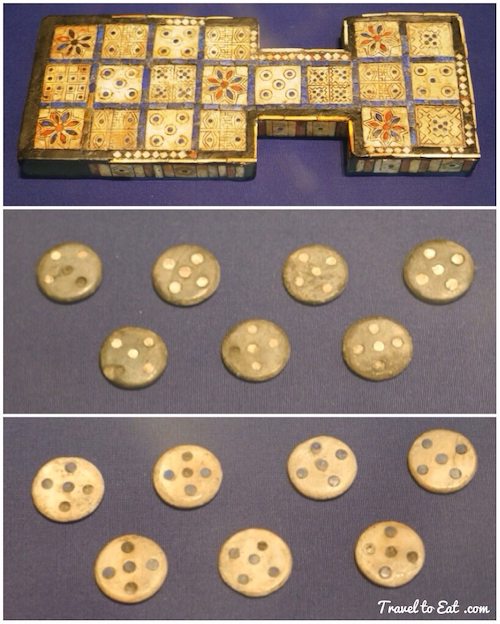
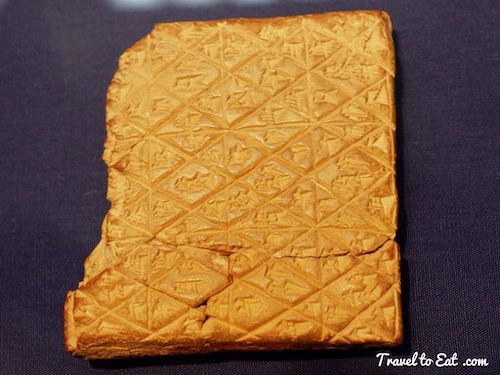
The British Museum is a treasure trove of innumerable objects. I had some pictures of ancient games and I thought I would share. For thousands of years, board games have been a source of entertainment for people across the world. Evidence of board games pre-dates the development of writing, and in many cultures they have even come to have a religious significance. The Royal Game of Ur, seen above, is the oldest-known board game for which the original rules survive. The oldest sets, discovered in Iraq in the 1920s, date to around 2600 B.C. The game had been thought long-dead, superseded by backgammon 2000 years ago, until game enthusiast Irving Finkel (who had poetically discovered the game’s rules carved into an ancient stone tablet) stumbled upon a surprising photograph of a game board from modern India. A small amount of detective work later, Finkel met a retired schoolteacher who had played what was basically the same game as a youngster—making this the game that has been played for longer than any other in the history of the world.
There are four basic kinds of ancient games.
- Race games, as in the ancient Egyptian Senet game, or backgammon, in which a player tries to advance all of his pieces to a defined finish line
- Position games, similar to tic-tac-toe. These are games in which a player tries to position his pieces in a winning position over his opponent’s pieces
- War games, such as chess, checkers or Tafl
- Forms of Mancala games − a group of logic games originating in Africa, and which spread around the world together with the slave trade. The game hones tactics of moving seeds into holes or also called count and capture games
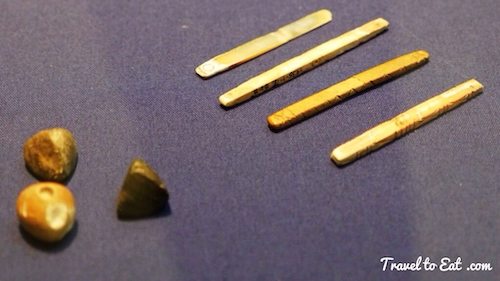
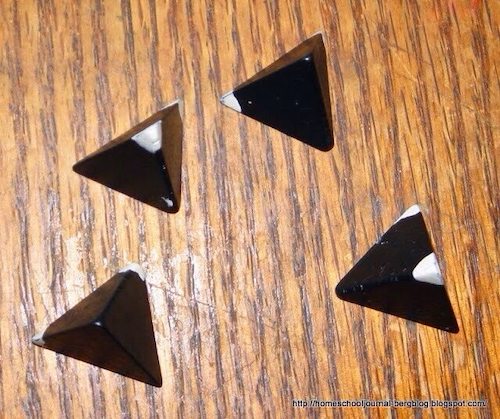
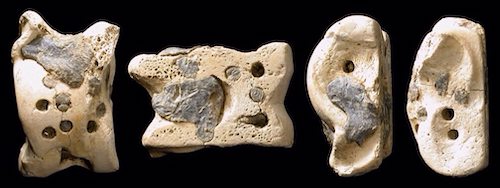
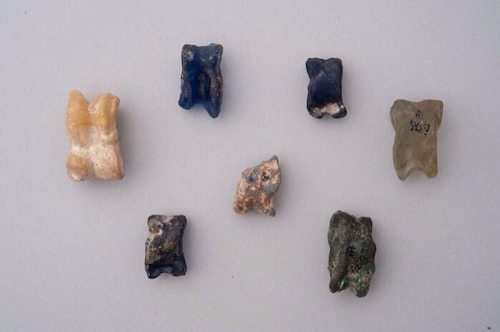
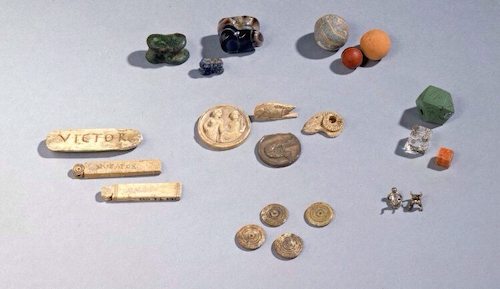
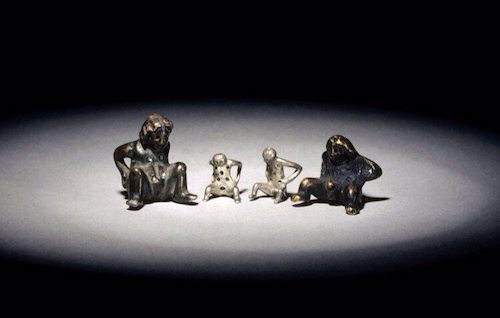
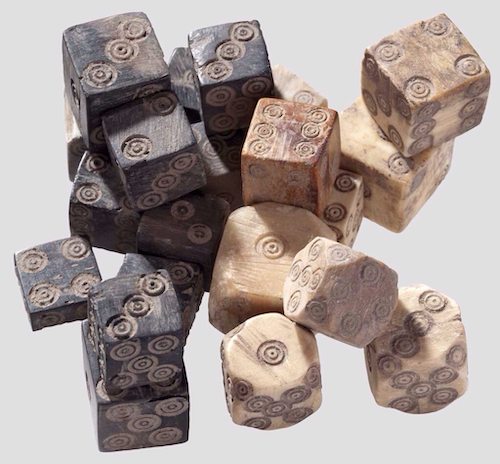
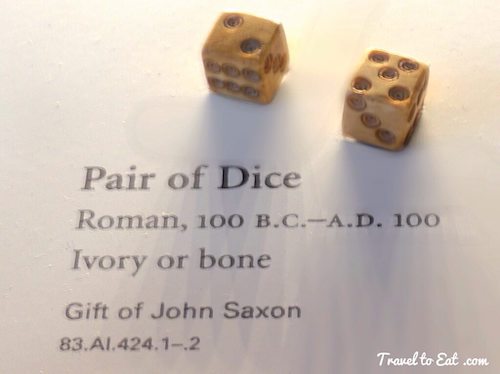
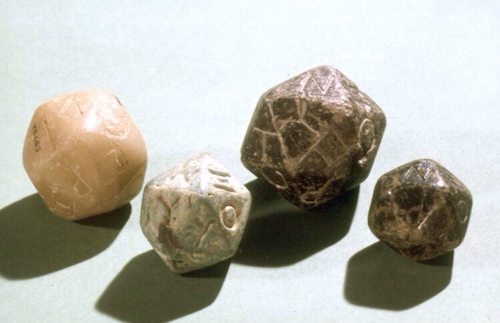
Dice are the centerpiece of most race board games, introducing the element of chance into the games. The first dice were stick dice. For dice, the ancient Egyptians used 4 wooden sticks, each one with a painted or decorated side and a plain side. They would throw all 4 sticks and the combination of plain and painted sides would determine how many moves they had. Four sided dice were used by the Mesopotamians almost 5000 years ago and had a hole or “pip” on two of the four tips. Thus, throwing the dice would give a one or zero facing up, these functioned like a coin or stick dice. Some of the earliest dice were made from the knuckle-bone of an animal, drilled and filled with lead for weighting. These were thrown like modern dice, and each side bore a different significance. Although knucklebone pieces were originally made from the knucklebones of sheep or goats, they were later crafted in a great variety of materials: brass, copper, silver, gold, glass, bone, ivory, marble, wood, stone, bronze, terracotta and precious gems. Roman era dice look much like the six sided dice we have today although some had the corners cut off with extra pips. Most Greek and Roman dice were made of bone or ivory
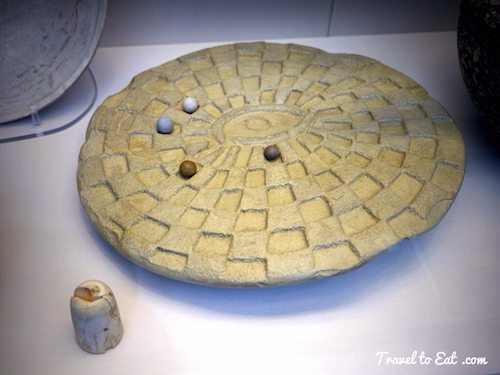
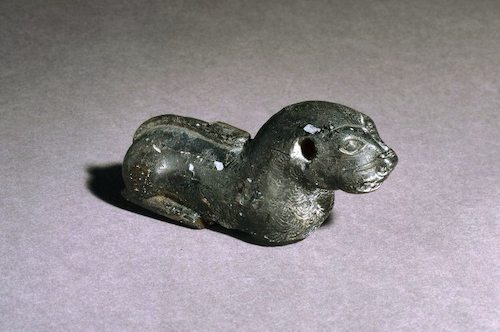
No rules for playing the race game, Mehen, have ever been discovered. However, a similar Arab game, known as the Hyena Game, shared remarkable characteristics for the board and pieces to Mehen. Because of this, the game play utilized in the Hyena game has been adapted to fit the game of Mehen. Players each begin with six marbles and one lion. Throwsticks determine movement. Players start at the tail, along the outer edge of the board, and move towards the center where the snake’s head rests. The players race to the center with their marble-like pieces. Once a marble reaches center, turns back out and reaches start again, the lion piece is put into play. This predatory piece is then used to capture (eat) an opponent’s marble pieces. The Sun Cult envisioned the god Mehen as a huge serpent who wrapped the Sun God Re in its coils when he set in the west and protected him on his journey, on the river of night, from the evil forces of the underworld. But at some point, perhaps even before the Old Kingdom, the game and the god became intertwined. The game became more than just a simple pastime, and began to take on religious aspects – so much so that the game became deliberately confused (syncretized, is the proper term) with the serpent deity in texts and thought. In fact, to quote Tim Kendall, “it is not possible to know (with the evidence we have) if this deity was inspired by the game itself, or whether the game was inspired by an already existing mythology.” As a result the game stopped being even played in the New Kingdom.
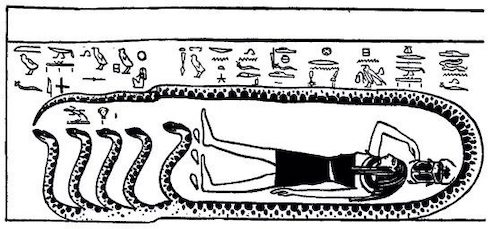
The book of Am Tuat is a three volume collection of texts and commentary about the Ancient Egyptian alternate reality called the Tuat. The Tuat was both the region that the boat of the Sun God Ra traversed during the night, and the place where inhabitants of this world went after death. Each chapter deals with one of the twelve hours of the night. A hallucinogenic travelogue of the netherworld, this extensively illustrated book depicts hundreds of gods and goddesses that appear nowhere else in the literature. I personally love the inventiveness of Egyptian religious beliefs and this one in particular. The concept of a snake enveloping the sun for protection through the netherworlds is both intriguing and poetic.
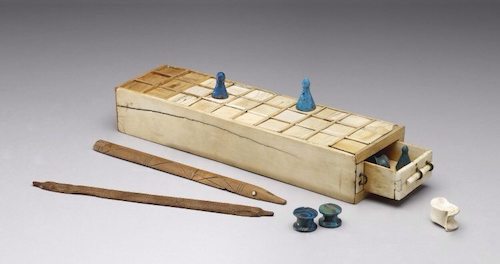
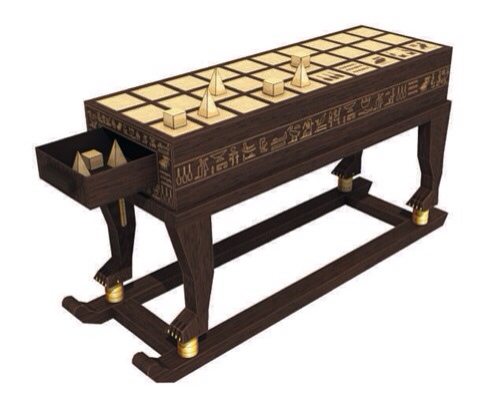
Board games were very popular among all levels of society in Egypt, especially the game of Senet, or ‘passing’. The game was first played in the Predynastic period, and a form of it is still played in Egypt today. Senet could be played with highly decorated sets, plain sets or simply on a grid of three rows of ten squares scratched in the dust or on a stone. Each player had a set of seven pieces. The players threw sticks or knuckle bones to move around the board via the squares indicating good or bad fortune. The object of the game was to safely navigate all the pieces off the board, while preventing the opponent from doing the same. The game board had thirty squares laid out in three rows of ten. Some of the squares had symbols on them and the path of the counters probably followed a reversed S across the board. The symbols represented either good or bad fortune, and affected the play accordingly.
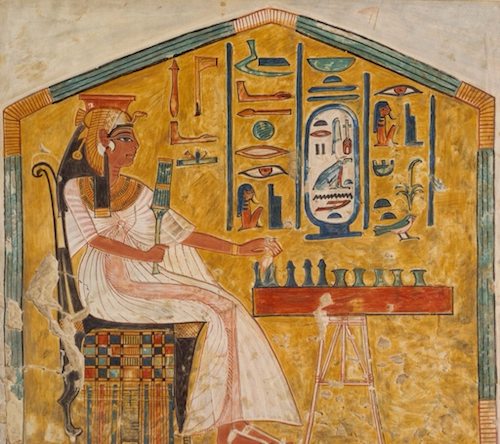
This facsimile copies one of the paintings from Queen Nefertari’s tomb. In this vignette, the queen is in front of a table and is playing a game of senet in which her invisible opponant is fate. She wears an elaborately pleated and fringed gown of sheer linen. She also wears a gold bracelet, a broad collar, and what are probably silver earrings. On her head is the vulture headdress of a queen. The facsimile was painted at the tomb in 1921-1922 by Nina de Garis Davies who was a member of the Graphic Section of the Met Museum’s Egyptian Expedition.
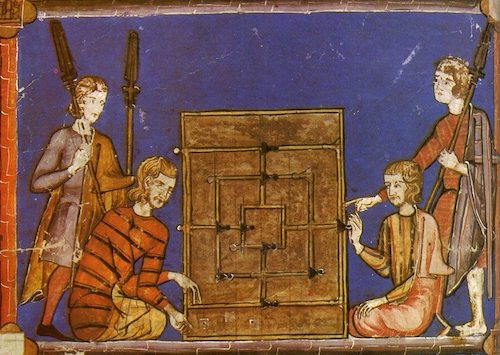
Nine Men’s Morris is a strategy position board game for two players that emerged from the Roman Empire. The game is also known as Nine Man Morris, Mill, Mills, The Mill Game, Merels, Merrills, Merelles, Marelles, Morelles and Ninepenny Marl in English. It may be the forerunner of tic-tac-toe. The first person to play puts a piece over any of the white circles on your gameboard. Then the second person does the same. Your objective is to get three of your pieces in a row (which is called a “mill”). All the pieces in a “mill” must be on circles which are connected by lines. In other words, diagonal mills don’t count. When you get a mill, you may remove and keep one of your opponent’s pieces from the board. The only time a piece can be removed from an opponent’s mill is when there are no other pieces available except those in a mill. Once both players have put down all their pieces, they take turns moving their pieces along the lines in an effort to form a mill. You can only move one space at a time, and you can’t move diagonally. Also, you may only move to adjacent open circles. You may not bump or jump an opponent’s piece. Again, the forming of a mill allows for the removal of an opponent’s piece.
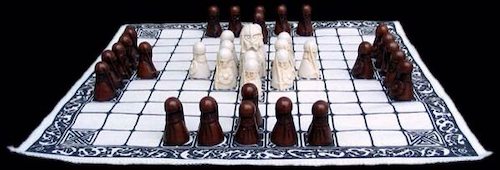
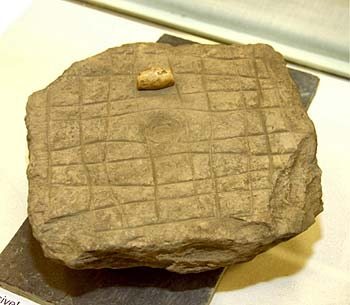
While most of the world knows how to play the ancient games of backgammon, chess and draughts, there is an almost forgotten game, comparatively ancient, which hangs like a spectre over a large part of northern Europe. This game is hnefatafl, also known in its various forms as tafl, brandubh, tawlbwrdd, alea evangelii and tablut, and less certainly by some as gwyddbwyll and ficheall. It is a game of skill in which a king tries to escape, with the help of his men, from a numerous besieging army. Hnefatafl began its life in Scandinavia. It probably developed from a Roman war game called ludus latrunculorum, which in turn developed from petteia, a game of the Greeks. In its Scandinavian form, hnefatafl was taken through trade and invasion to the British Isles, to Iceland, France, Germany, the Ukraine and to Greenland. In addition to many finds in its ancestral home, boards, pieces and literature for many variants have been found in diverse parts of northern Europe. The game flourished in Europe until the arrival of chess.
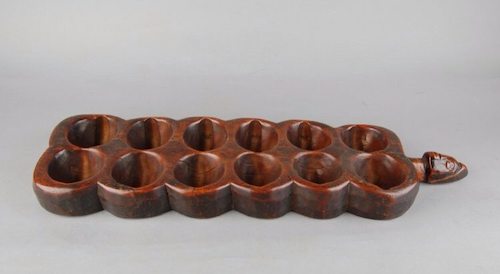
Mancala refers to a family of games with the same basic method of play. Known as count-and-capture games, there is some evidence to suggest that they may be the earliest games played—predating even Senet but further verification is needed. To play the game, all you need is a patch of soft ground and a handful of seeds or pebbles. Rows of holes are dug alongside one another, and players distribute counters one at a time in a path round the board. There are a number of goals, but the key to victory in every version is basically to count really fast.
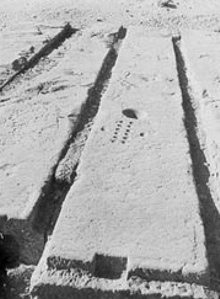
A game board similar to Mancala was found on the roof of the temple of Seti I in Egypt. The Temple of Seti I was completed by Ramses II for his father, Seti I, likely within the first 5 years of his reign (1279-1213 BC). It was used as part of the Abydene pilgrimages for over 1000 years, and was eventually closed down during the Roman period. Since roofs of temples were often used by priests to observe the stars, they would spend hours in these locations. When waiting for the stars to come out, or for the sky to clear, they apparently played games. There are numerous game boards are hollowed out in the sandstone blocks of the temple.
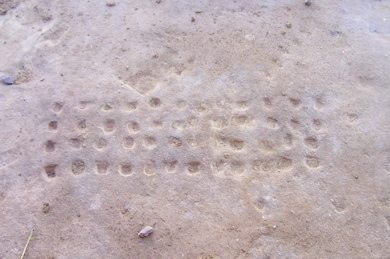
Some of the oldest evidence of Mancala is found in the National Geographic sponsored archaeological diggs that searched back to 7,000 to 5,000 BC in present-day Jordan. Excavations of an ancient house uncovered a limestone slab with two parallel rows of circular depressions. The layout was easily recognizable to an archaeologist on the dig as a Mancala playing board. Many experts surmise that Mancala may in fact be the oldest board game ever.
References:
10 Most Important Board Games: http://listverse.com/2013/01/20/10-most-important-board-games-in-history/
Dice Collection: https://averweij.web.cern.ch/averweij/
Knucklebones: http://archaeologicalmuseum.jhu.edu/the-collection/object-stories/archaeology-of-daily-life/childhood/knucklebones/
Book of Am Tuat: http://www.ciamarra.com/tuat/tuat.htm
Hnefatafl: https://www.facebook.com/HnefataflBoardGame
Mancala: http://nabataea.net/gameskids.html
Royal Game of Ur: http://www.gamecabinet.com/history/Ur.html
Online Royal Game of Ur: http://www.yourturnmyturn.com/java/ur/index.php

